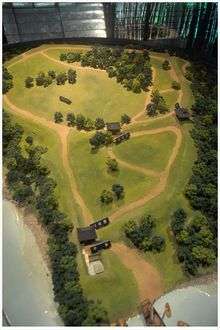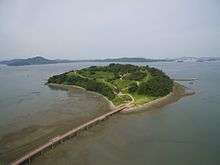Cheonghaejin
Cheonghaejin (literally "Blue sea headquarters") was a major military headquarters and trading hub located on Wando island, South Jeolla province of South Korea, and established by Korean general Jang Bogo in 828 ACE during the Silla kingdom period.[1] It traded mainly with Tang Dynasty China and Japan, and served as a military hub to combat various pirate factions.[2][3]
| Cheonghaejin | |
 | |
| Korean name | |
|---|---|
| Hangul | 청해진 |
| Hanja | |
| Revised Romanization | Cheonghaejin |
| McCune–Reischauer | Ch'ŏnghaejin |
History
Cheonghaejin was established originally as a military complex by General Jang Bogo in 828, the third year of King Heungdeok's reign. Jang appealed to Heungdeok to establish a military complex in Cheonghaejin to protect Silla's merchant fleets and coastal residents from pirates. He was granted permission and 10,000 troops. He established a small castle and a military base in Garipo.
Cheonghaejin was very successful in its mission; it maintained strong commercial ties with Chinese and Japanese trading ports and successfully protected Silla merchants and coastal residents from pirates. Jang sent envoys called Hoyeoksa (호역사) for trading activities and cultural exchange.
It was resented by many Silla noblemen of small maritime societies because they lost their profits from private maritime trades. The noblemen of Silla sent an assassin, Yeom Jang, to assassinate Jang. After Jang's assassination, the complex was maintained by Yeom Jang himself, but the residents of Cheonghaejin, mourning Jang's death, left Cheonghaejin. They mostly moved to other regions of Silla, while some moved to China or Japan. It is recorded in Samguk Sagi that the central Silla government closed Cheongjaejin in February 851. The remaining residents were then relocated to Byeokgolgun.
Modern times
Cheonghaejin is now located in Wando County, Jeollanam-do, and is a main tourist location in the region. There is a stele commemorating the relocation of residents of Cheongjaejin to Byeokgolgun and various remains of the complex. Remains of various mercantile products and plates have been discovered in Cheongjaejin, which greatly contributed to understanding the life of Silla people.
Historical Site

The historic site of Cheonghaejin is the site of a military fortress dating back to the Unified Silla period located on Jangdo at 734 Jangjwa-ri, Wando-eup, Wando-gun, Jeollanam-do. The distance from Wando (island) to Jangdo is about 180m, which can be covered on foott twice a day when the ebbing tide exposes the seabed.
It is a major historical site where in the 9th century during the Unified Silla, General Jang Bogo installed Cheonghaejin and cracked down on pirates and let the place serve as the stronghold for a maritime trading route that dominated the maritime trade in the seas off the three sides of the Korean Peninsula.
The Ruins and Relics
- Wooden Fence (Wonmokryeol): Presumed to be a wooden fence designed to defend the entrance of the island, Wonmokryeol has a length of 331m and is mostly made of oak posts. When the wooden fence specimen was put to radiocarbon dating, it was identified as dating to the mid-9th century.[4]
- Cheonghaejin Castle: Stretching 890m, the castle construction used rammed earth, which arrays in parallel one or two layers of stones at intervals of 5-6m and compacts earth inside the framework to stack up in a robust manner.[4]
- Historic Site of Beobhwasa(Hangul:법화사터): At the foot of Sanghwang-bong (‘peak’) that stands behind Jangjwa-ri lies the old site of Beobhwa-sa (‘Buddhist temple’) reportedly constructed in imitation of Beobhwawon that Jang Bogo built in Chishan(赤山), Shandong Province.
- ㄷ-Shaped Vestiges of Rammed Earth Construction and the Well: The ㄷ-shaped vestiges of rammed earth construction is a costal structure, which is unexampled not only at home but also in China and Japan. The ㄷ-shaped vestiges of rammed earth construction serves to protect the well and reinforce the outer castle gate. The remaining depth of the well is 5.8m, from which various artifices such as wrinkled vase and iron pieces were excavated.[5]
- Oeseongmun (‘Outer Castle Gate’): As a passage that connects the inside and outside of the castle, it serves to deter enemy attacks, stage counterattacks, or defeat enemies.[5]
- Naeseongmun (‘Inner Castle Gate’): It is the second gate inside the castle with a defensive purpose.[5]
- Godae (‘High Site’): Located at the middle of the castle wall south of Cheonghaejin that runs from east to west, it is a vantage point at the passage that leads inland from overseas, from which it was easy to monitor offshore commercial ships and pirates.[5]
 Panoramic view of Cheonghaejin.
Panoramic view of Cheonghaejin. View seen from the ramp of Cheonghaejin. From left to right, "Oeseongmun Gate", "Naeseongmun Gate", and a shrine are shown.
View seen from the ramp of Cheonghaejin. From left to right, "Oeseongmun Gate", "Naeseongmun Gate", and a shrine are shown. A large well in front of Oeseongmun. Its vicinity is surrounded by earthen walls.
A large well in front of Oeseongmun. Its vicinity is surrounded by earthen walls. View of Oeseongmun overlooked from Naeseongmun
View of Oeseongmun overlooked from Naeseongmun Part of the wall
Part of the wall Part of the wall sectioned to show the state of heaping and hardening of earth (panchuk in Korean).
Part of the wall sectioned to show the state of heaping and hardening of earth (panchuk in Korean). Chi, a distinctive Korean wall style. Two chi have been preserved in Cheonghaejin.
Chi, a distinctive Korean wall style. Two chi have been preserved in Cheonghaejin.
References
- by the translators of Il-yeon's: Samguk Yusa: Legends and History of the Three Kingdoms of Ancient Korea, translated by Tae-Hung Ha and Grafton K. Mintz. Book Two, page 102. Silk Pagoda (2006). ISBN 1-59654-348-5
- 청해진 淸海鎭 [Cheonghaejin] (in Korean). Nate / Encyclopedia of Korean Culture. Archived from the original on 2011-06-10. Retrieved 2010-01-04.
- 청해진 淸海鎭 [Cheonghaejin] (in Korean). Nate / Britannica. Archived from the original on 2011-06-10. Retrieved 2010-01-04.
- "완도 청해진유적(莞島 淸海鎭遺蹟) - 한국민족문화대백과사전". encykorea.aks.ac.kr.
- Reference to Local signs